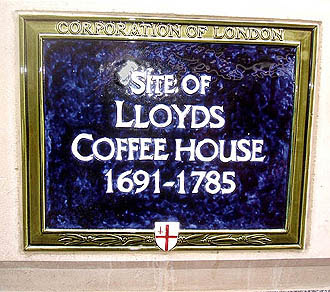Because in all of the whole human race
Mrs Lovett, there are two kinds of men and only two
There's the one they put in his proper place
And the one with his foot in the other one's face
Look at me, Mrs Lovett, look at you. (Sweeney Todd lyrics)

A history of insurance starting with Lloyd’s of London
Lloyd’s of London is neither a company nor a corporation. It is basically a British insurance market. It serves as a meeting place where multiple financial backers or “members”, whether individuals, who are known as “Names” or corporations, come together to pool and spread risk. Their main business is in the reinsurance market.

The market began in Edward Lloyd’s coffeehouse around 1688 in Tower Street, London. His establishment was a popular place for sailors, merchants, and ship owners. Lloyd’s main business with his customers was to provide reliable shipping news, which he gleaned from all his different customers and then fed back to them. The shipping industry community frequented the place to discuss insurance deals among themselves.

Soon after Christmas in 1691, the coffee shop moved to Lombard Street, where today a blue plaque commemorates its location. Long after Lloyd’s death in 1713 the arrangement continued until 1774 when the participating members of the insurance arrangement formed a committee and moved to the Royal Exchange, and called itself The Society of Lloyd’s.

Between 1688 and 1807, slave trading became one of the primary constituents of all British trade, and the dangers in the slave trade meant that insurance of the ships was of major concern. The insurance of ships engaged in slave trading became one of the primary sources of Lloyd’s business as Britain established itself as the chief slave trading power in the Atlantic. With slave-trading forming such a prominent part of Lloyd’s business, the organization was one of the chief opponents to the abolition of the slave trade.

In 1838 the Exchange burned down and, although rebuilt, many of Lloyd’s early records were lost. In 1871, the first Lloyd’s Act was passed in Parliament which elevated the business to a legal footing. The Lloyd’s Act of 1911 set out the Society’s objectives, which include the promotion of its members’ interests and the collection and dissemination of information.

It soon became apparent that the membership of the Society, which was largely made up of market participants, was too small in relation to the risks that it was underwriting and the small market capitalization. Lloyd’s commissioned a secret internal inquiry, known as the Cromer Report, which reported in 1968. This report advocated the widening of membership to non-market participants, including non-British subjects and women, and to reduce the onerous capitalization requirements, which created a minor investor known as a ‘mini-Name’. (source: Health Insurance Net)
There's a hole in the world like a great black pit
and the vermin of the world inhabit it
and its morals aren't worth what a pig can spit
and it goes by the name of London...
At the top of the hole sit the privileged few
Making mock of the vermin in the lonely zoo
turning beauty to filth and greed...
I too have sailed the world and seen its wonders,
for the cruelty of men is as wondrous as Peru
but there's no place like London! (lyrics: "No Place Like London" from Sweeney Todd)
No comments:
Post a Comment